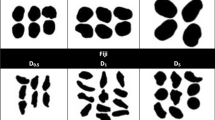Abstract
Drying dissipative patterns during drying of marine colloidal (MC) clays were observed in the deionized aqueous suspension on a cover glass, a watch glass, and a Petri glass dish. Two kinds of broad rings (BR), i.e., BR of small particles at the outside edge and BR of large particles at the inner area from the edge, were observed. The size of the outside BR was the same as that of the initial suspension irrespective of colloidal concentration, whereas the size of the inner BR increased as colloidal concentration increased. Highly distorted multi-rings, i.e., branch-like or net-like patterns, appeared. Furthermore, no spoke lines formed except the areas at the outside edge of the dried film. These observations support the circular stacking of the anisotropic-shaped MC particles during the convectional flow process. The B type of solutes was deduced for MC from the drying patterns, where strong solute-substrate affinity especially for the small particles and weak inter-solute affinity coexist.








Similar content being viewed by others
References
Deegan RD, Bakajin O, Dupont TF, Huber G, Nagel SR, Witten TA (1997) Capillary flow as the cause of ring strains from dried liquid drops. Nature 389:827–829
Deegan RD, Bakajin O, Dupont TF, Huber G, Nagel SR, Witten TA (2000) Contact line deposits in an evaporating drop. Phys Rev E 62:756–765
Kralchevsky PA, Nagayama K (2000) Capillary interactions between particles bound to interfaces, liquid films and membranes. Adv Colloid Interf Sci 85:145–192
Okubo T (2015) Colloidal organization. Elsevier, Amsterdam
Deegan RD (2000) Pattern formation in drying drops. Phys Rev E 61:475–485
Cachile M, Benichou O, Cazabat AM (2002) Evaporating droplets of completely wetting liquid. Langmuir 18:7985–7990
Hu H, Larson RG (2005) Analysis of the microfluid flow in an evaporating sessil droplet. Langmuir 21:3963–3971
Bonn SN, Rafai S, Azouni A, Bonn D (2006) Evaporating droplets. J Fluid Mech 549:307–313
Gribbin G (1999) Almost everyone’s guide to science. The universe, life and everything. Yale University Press, New Haven
Ball P (1999) The self-made tapestry. Pattern formation in nature,. Oxford Univ Press, Oxford
Terada T, Yamamoto R, Watanabe T (1934a) Experimental studies on colloid nature of Chinese black ink. Part. 1. Sci Paper Inst Phys Chem Res Jpn 23:173–184
Terada T, Yamamoto R, Watanabe T (1934b) Experimental studies on colloid nature of Chinese black ink. Part. 2. Sci Paper Inst Phys Chem Res Jpn 27:75–92
Nakaya U (1947) Memoirs of Torahiko Terada (Japanese). Kobunsya, Tokyo
Palmer HJ (1976) The thermodynamic stability of rapidly evaporating liquids at reduced pressure. J Fluid Mech 75:487–511
Anderson DM, Davis SH (1995) The spreading of volatile liquid droplets on heated surfaces. Phys Fluids 7:248–265
Routh AF, Russel WB (1998) Horizontal drying fronts during solvent evaporation from latex films. AIChEJ 44:2088–2098
Burelbach JP, Bankoff SG (1998) Nonlinear stability of evaporating/condensing liquid films. J Fluid Mech 195:463–494
Fischer BJ (2002) Particle convection in an evaporating colloidal droplet. Langmuir 18:60–67
Okubo T, Okamoto J, Tsuchida A (2009a) Convectional, sedimentation and drying dissipative structures of coffee in the presence of cream and in its absence. Colloid Polym Sci 287:351–365
Okubo T (2009) Convectional, sedimentation and drying dissipative structures of black tea in the presence of cream and in its absence. Colloid Polym Sci 287:645–657
Vanderhoff JW (1973) The transport of water through latex films. J Polym Sci Symp 41:155–174
Nicolis G, Prigogine I (1977) Self-organization in non-equilibrium systems. Wiley, New York
Ohara PC, Heath JR, Gelbart WM (1997) Bildung von submikronmeter-grossen partikel ringen beim verdunsten nanopartikel-hattiger losungen. Angew Chem 109:1120–1122
Maenosono S, Dushkin CD, Saita S, Yamaguchi Y (1999) Growth of a semiconductor nanoparticle ring during the drying of a suspension droplet. Langmuir 15:957–965
Nikoobakht B, Wang ZL, El-Sayed MA (2000) Self-assembly of gold nanorods. J Phys Chem 104:8635–8640
Ung T, Litz-Marzan LM, Mulvaney P (2001) Optical properties of thin films of Au@SiO2 particles. J Phys Chem B 105:3441–3452
Okubo T, Kokufuta E, Nakamuro M, Yoshinaga K, Mizutani M, Tsuchida A (2010) Drying dissipative structures of lycopodium spore particles in aqueous dispersion. Colloids Surf B Biointerf 80:193–199
Jacobs MB, Ewing M (1965) Mineralogy of particulate matter suspended in sea water. Science 149:179–180
Russ JC (1971) Energy dispersion X-ray analysis on the scanning electron microscope. In: Energy Dispersion X-ray Analysis and Electron Probe Analysis. Am Soc Testing Mater Spec Pub 485:pp154–pp179
Bassin NJ (1975) Suspended marine clay mineral identification by scanning electron microscopy and energy-dispersive X-ray analysis. Limnology Oceanography 20:133–137
Okubo T, Okamoto T, Okamoto J, Tsuchida A (2008a) Sedimentary and drying dissipative patterns of binary suspensions of colloidal silica spheres having different sizes. Colloid Polym Sci 286:385–394
Okubo T, Okamoto J, Tsuchida A (2008b) Sedimentation and drying dissipative patterns of ternary mixtures of colloidal silica spheres having different sizes. Colloid Polym Sci 286:941–949
Okubo T, Tsuchida A, Togawa H (2009b) Drying dissipative patterns of aqueous solutions of simple electrolytes and their binary mixtures on a cover glass. Colloid Polym Sci 287:443–454
Okubo T (2011) Dissipative crystallization of aqueous mixtures of potassium salts of poly(riboadenylic acid) and poly(ribouridylic acid). Colloids Surf B Biointerf 87:11–17
Okubo T (2013) Inclusional association as studied by the drying dissipative structure. Part 3. Drying patterns of aqueous mixtures of β-cyclodextrin and n-alkyltrimethylammonium bromide. Colloid Polym Sci 291:2599–2605
Okubo T (2014) Dissipative crystallization of aqueous mixtures of potassium salts of poly(riboguanylic acid) and poly(ribocytidylic acid). Colloid Polym Sci 292:1419–1427
Okubo T, Otake A, Tsuchida A (2009c) Drying dissipative structures of the aqueous suspensions of palygorskite and tungstic acid particles. Colloid Polym Sci 287:1435–1444
Yamaguchi T, Kimura K, Tsuchida A, Okubo T, Matsumoto M (2005) Drying dissipative structures of the aqueous suspensions of monodispersed bentonite particles. Colloid Polym Sci 283:1123–1130
Author information
Authors and Affiliations
Corresponding author
Rights and permissions
About this article
Cite this article
Okubo, T., Kitano, H., Murou, M. et al. Drying structures of marine clay in the deionized aqueous suspension. Colloid Polym Sci 293, 3393–3401 (2015). https://doi.org/10.1007/s00396-015-3740-3
Received:
Revised:
Accepted:
Published:
Issue Date:
DOI: https://doi.org/10.1007/s00396-015-3740-3




